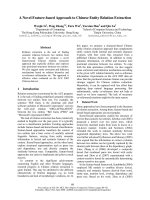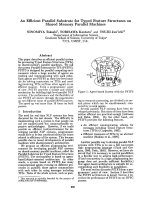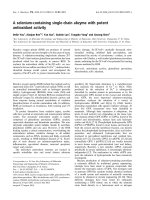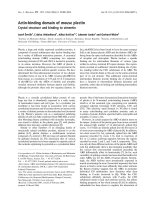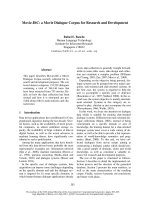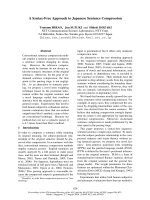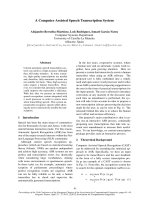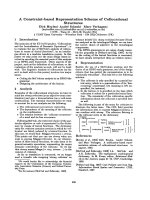Báo cáo khoa học: "A TRANSFER MODEL USING A TYPED FEATURE STRUCTURE REWRITING SYSTEM WITH INHERITANCE" pot
Bạn đang xem bản rút gọn của tài liệu. Xem và tải ngay bản đầy đủ của tài liệu tại đây (485.06 KB, 6 trang )
A TRANSFER MODEL USING A TYPED FEATURE STRUCTURE
REWRITING SYSTEM WITH INHERITANCE
R6mi Zajac
ATR Interpreting Telephony Research Laboratories
Sanpeidani lnuidani, Seika-cho~ Soraku-gun, Kyoto 619-02, Japan
[zajac%]
ABSTRACT
We propose a model for transfer in machine
translation which uses a rewriting system for typed
feature structures. The grammar definitions describe
transfer relations which are applied on the input
structure (a typed feaane structure) by the interpreter to
produce all possible transfer pairs. The formalism is
based on the semantics of typed feature structures as
described in [AR-Kaci 84].
INTRODUCTION
We propose a new model for transfer in machine
translation of dialogues. The goal is twofold: to
develop a linguistically-based theory for transfer, and to
develop a computer formalism with which we can
implement such a theory, and which can be integrated
with a unification-based parser. The desired properties
of the grammar are (1) to accept as input a feature
structure, (2) to produce as output a feature structure,
(3) to be reversible, (4) to be as close as possible to
current theories and formalisms used for linguistic
description. From (1) and (2), we need a rewriting
formalism where a rule takes a feature structure as
input and gives a feature structure as output. From O),
this formalism should be in the class of unification-
based formalisms such as PROLOG, and there should
be no distinction between input and output. From (4),
as the theoretical basis of grammar development in
ATR is HPSG [Pollard and Sag 1987], we want the
formalism to be as close as possible to HPSG.
To meet these requirements, a rewriting system for
typed feature structures, based on the semantics of
typed feature structures described in [AR-Kaci 84], has
been implemented at ATR by Martin Emele and the
author [Emele and Zajac 89].
The type system has a lattice structure, and
inheritance is achieved through the rewriting
mechanism. Type definitions are applied by the
interpreter on the input structure (a typed feature
structure) using typed unification in a non-deterministic
and monotonic way, until no constraint can be applied.
Thus, the result is a set of all possible transfer pairs.
compatible with the input and with the constraints
expressed by the grammar. Thanks to the properties of
the rewriting formalism, the transfer grammar is
reversible, and can even generate all possible pairs for
the grammar, given only the start symbol
TRANSLATE.
We give an outline of the model on a very simple
example. The type inheritance mechanism is mainly
used to classify common properties of the bilingual
lexicon (sect. 1), and rewriting is fully exploited to
describe the relation between a surface structure
produced by a unification-based parser
and
the abstract
structme used for transfer (sect. 2), and to describe the
relation between Japanese
and
English structures (sect.
3). An example is detailed in sect. 4.
1. LEXICAL TRANSFER AS A
HIERARCHY OF BILINGUAL LEXICAL
DEFINITIONS
The type system is used to describe a hierarchy of
concepts, where a sub-concept inherits all of the
properties of its super-concepts. The use of type
inheritance to describe the hierarchy of lexical types is
advocated for example in [Pollard and Sag 1987, "
chap.8].
We use a type hierarchy to describe properties
which are common to bilingual classes of the bilingual
lexicon. The level of description of the bilingual
lexicon is the logico-semantic level: a verb for example
has
a relational role and links different
objects
through
semantic relations (agent, recipient, space-location ).
Semantic relations in the bilingual lexicon are
common to English and Japanese.
Predicates can be classified according to the
semantic relations they establish between objects. For
example, predicates which have only an agent case are
defined as Agent-Verbs, and verbs which also have a
recipient role are defined as Agent-Recipient-Verbs, a
sub-class of Agent-Verbs. On the leaves of the
hierarchy, we find the actual bilingual entries, which
describe only idiosyncratic properties, and thus are very
simple.
The translation relation defined by TRANSLATE
is described in sect. 3. We shall concentrate on the
propositional part PROP defined here as a disjunction of
types:
PROP = SPEAKER I HEARER I REG-~mM I BOCK r
ASK I ~ I TCt~4 I NEGATIC~
The simple hierarchy depicted graphically
Figure
1
is written as follows:
VERB
s
[japanese:JV[relaticn:JPROP],
english:EJ [relation:EPROP] ].
AG-VERB = VERB[japanese: [agant:#j-ag],
english: [agent: #e-ag],
trans-ag: PR~P
[ japanese: #j-ag,
english: #e-ag] ].
in
This definition can be read: an Agent-Verb is-a
Verb which has-properties
agent
for Japanese and
English. We need to express how the arguments of a
relation are translated. This is specified using a
trar~late-ag slot with type symbol Pimp, which
will be used during the rewriting process (see details in
sect
3 and 4). Symbols prefixed with # are tags, which
are used to represent co-references (~sharing>O of
slructures.
In this clef'tuition, we have a one-to-one mapping
between the agent argument, and at this level of
representation (semantic relations), this simple case
arises frequently. However, we must also describe
mappings between structures which do not have such
simple correspondence, such as idiomatic expressions.
In that case, we have to describe the relation between
predicate-argument structures in a more complex way,
as shown for example in sect.4.
AG-BEC-V = ~C V
[ japanese: [recipient: #j-recp],
english: [recipient: #e-recp],
trans-recp: P~ [japanese: #j-recp,
english: #e-recp] ].
;CJ-REC-OBJ-V ~ ~J-BEC-V
[japanese: [object: #j-obj],
english: [object: #e-obj],
trans-obj :PBOP [ japanese: #j-obj,
eng] 18h: #e-obj ] ].
NOUN- [japanese:JN, english:EN].
Actual bilingual entries are very simple thanks to
the inheritance of types.
SE~D = ~69-REC-fBJ-V[japanese: [reln:OK~JRU-l],
english: [reln:SEMD-I] ].
ASK -
~3-REC-V[japanese: [reln:OKIKI-l],
english: [reln:ASK-l] ].
~ -NOUN
[japanese :~SHI-I,
english: REGISTRATIC~-FO~-I ].
B-HEARER
=
NCE~[japanese:J-HEARE~
english:E-HEARER].
B-SPEAKER - ~ [ japanese: J-SPEAKER,
eng]~ ~h: E-SPEAKER].
PROP
I
°°''"
SPEAKER HEARER REG-FORM ASK SEND
Figure 1: a simple hierarchy of types.
The type system is interpreted using the rewriting
mechanism described in [Ait-Kaci 84], which gives an
operational semantics for type inheritance: a feature
structure which has a type ~3 v for example is unified
with the definition of this type:
[ japanese: [agent: #j-ag],
english: [agent: #e-ag],
trans-ag: PBOP [ japanese: #j-ag,
~glish: #e-ag] ]
and the type symbol AG-V is replaced with the super-
type VERB in the result of the unification. If type VERB
has a deC'tuition, the structure is further rewritten, thus
achieving the operational interpretation of inheritance.
Disjunctions like Pt~Dp create a non-deterministic
choice for further rewriting: the symbol E,I~Dp is
replaced with the disjunction of symbols of the right-
hand-side creating alternative paths in the rewriting
process. This process of rewriting is applied on every
2
sub-structure of a structure to be evaluated, until no
type symbol can be rewritten.
As the rewriting system does not have any explicit
control mechanism for rule application, whenever
several rules are applicable all paths are explored, and
all solutions are produced in a non deterministic way.
This could be a drawback for a practical machine
translation system, as only one translation should be
produced
in
the end, and due to the non deterministic
behavior of the system, this could also lead to severe
efficiency problems. However, the system is primarily
intended to be used as a tool for developing a linguistic
model, and thus the production of all possible
solutions is necessary in order to make a detailed study
of ambiguities.
Furthermore, according to the principles of second
generation MT systems [Ynvge 57, Vauquois 75,
Isabelle and Macklovitch 86], a transfer grammar
should be purely contrastive, and should not include
specific source or target language knowledge. As a
result, the synthesis grammar should implement all
necessary language specific constraints in order to rule
out ungrammatical strucmr~ that could be produced
after transfer, and make appropriate pragmatic
decisions.
2. RELATING SURFACE AND ABSTRACT
SPEECH ACTS
A problem in translating dialogues is to translate
adequately the speaker's communicative strategy which
is marked in the utterance, a problem that does not
arise in text machine translation where a structural
translation is generally found sufficient [Kume et al.
88]. Indirectness for example cannot be translated
directly from the surface structure produced by a
syntactic parser and needs to be further analyzed in
terms independent of the peculiarities of the language
[Kogure et al. 1988]. For example, take the
representation produced by the parser for the sentence
[Yoshimoto and Kogure 1988]:
watashi-ni tourokuyoushi-wo o-okuri jtadake, masu ka
I-dative
registration-form-acc honor-send can-rT.eive-a-favor
polite interr
Figure 2: example of a Japanese sentence
The representation has already
categorized to
a
certain
extent surface speech acts types. The level of
analysis produced by the parser is the level of semantic
relations (relation, agent, recipient, object, ). The
represonmfion reduced to relation fean~es is:
( ~-~ (CAN (RECEIVE-FA%~3R (OKL~J-1
(~Xm~2~S~-I)) ) ) )
The level of representation we want for transfer can
be basically characterized by (1) an abstract speech act
type (request, declaration, question, promise ), (2) a
manner (direct, indirect, ), and (3) the propositional
content of the speech act [Kume et al. 88]. A grammar,
written in the same formalism, abstracts the meaning
of the surface structm'e
to:
JhEA [ speech-act -type: REQUEST,
manner: I~DIRECT-ASKINC POSSIBrLTTY,
speaker:
#~ker-J-SPF,~'~%
hearer:
#hea~r-J-~
s-act: JVC~elaticn: O~J~J-1,
agent:
#hearer,
recipient:
#speaker,
object: ~-i]]
and this is the input for the transfer module.
3.
DEFINING THE TRANSFER RELATION
AT THE LOGICO-SEMANTIC LEVEL
Each structure which
represents
an utterance has
(I) an abswact speech act type, (2) a type of manner,
and (3) a propositional content Each sub-structure of
the propositional content has (I) a lexical head, (2) a
set of syntactic featur~ (such as tense-aspect-modality,
determination, gender ), and may have (3) a set of
dependents which are analyzed as case roles (agent,
time-location, condition ).
The manner and abstract speech act categories are
universals (or more exactly, common to this language
pair for this corpus), and need not be translated: they
are simply stated as identical by means of tag identity.
The part which represents the propositional
content is language dependant, and the translation
relation defined between lexical heads, syntactic features
and dependents of the heads is defined indirectly by
means of transfer rules. Thus, this approach can be
characterized as a mix of pivot and wansfer approaches
[Tsujii 87, Boitet
88].
speech-act.type REOUEST
manner INDIRECT-ASK.POSSIBILITY
speaker #0=J-SPEAKER
hearer #1=J-HEARER
s-act relation OKURU-1
agent #1
recipient #0
object TOUROKUYOUSHI-1
Figure 3:
direct
mapping
by tagging
Indirect
mapping by
rule
application
speech.act-type REOUEST
manner INDIRECT-ASK.POSSIBILITY
speaker #2=E-SPEAKER
hearer #3:E-HEARER
s-act
relation SEND-1
agent #3
recipient #2
object REGISTRATION-FORM-1
the translation relation.
The definitions of the transfer grammar can be
divided into three groups:
1) definitions that state equality of abstract speech act
type and manner (the language independent parts),
2) lexical def'mitions that relate predicate-argument
structures,
3) definitions that relate syntactic features (not yet
included in our
grammar).
sub-class of lexemes. For example, one can write
directly SP~ instead of
PROP
in the trans-spk slot
of the above definition. Another possibility for a
mono-directional system is to access the bilingual
lexicon using the Japanese entry during parsing. This
means that the dictionaries of the
system would
have to
be organized as a
single
integrated bilingual lexical
rhtabas~.
Starting from the abstract speech act description,
we need only one definition for specifying the direct
mapping of Abstract Speech Acts by tagging, which
also introduces the type symbol
PROP
that will trigger
the rewriting process for the transfer grmnmar:.
~LA.~ -
[ japanese: JASA
[speech-act-type: #sat,
manner: #manner,
speaker: #J-spk,
hearer: #j-hrr,
s-act: #j-act-u-PROP] ],
englimh: EASA
[speech-act-type: #sat,
manner: #manner,
speaker: #e-spk,
hearer: #e-hrr,
s-act: #e-act=EPROP] ],
trans-act: PI%0P [ japanese: # j-act,
english: #e-act ] ],
trans-spk: PIK)P [japanese: # j-spk,
english: #e-spk] ],
trans-hrr: PROP [japanese: #j-hrr,
english: #e-hrr] ]
.
In this simple example, the definition of the
symbol PR3P contains the full bilingual dictionary.
Unifying a structure with ~,l~Zi, means that a structure
is unified with a very large disjunction of clef'tuitions.
There are several possible ways to overcome this
problem. One can use the hierarchical type system to
restrict the set of candidates to a small sub-set of
definitions and instead of using pROP, use the most
adequate specific symbol for translating an argument:
such a symbol can be viewed as the initial symbol of a
sub-grammar which describes the transfer relation on a
4. A STEP BY STEP EXAMPLE
We give
in
this section a trace of a simple
example for the sentence in Figure 4. For translating,
we need to add to the definition of PRimP, the following
bilingual lexical definitions:
BOCK- hU3N[japanese:HCN-l, english:BOOK-l].
-IggXlq[japanese: TE-1, en~]tqh:HAlXD-l].
(japanese: (relation: ~JRERU-I,
object: TE-I,
spatial-destination: #0],
eng]L-h: [relation: TOUCH-I,
object: #i],
trans0:Pl~P[japanese: #0, english:#1]].
hon-ni te-wo fure-naide kudasai I
book-obl2 hand-ob/1
touch-neg please
Figure 4: don't touch the books!
A lexical definition introduces the PPJ3P symbol
for the arguments of a predicate, and the translation
relation is defined recursively between argument sub-
structures. There could be one-to-one mapping between
two substructures, but as in the example of 2~.X2H, the
relation is in general not purely compositional, and not
one-to-one, and argument description can be as refined
as necessary. Here, the object TE-1 (<~hand>>) is a part
of the meaning of ~touch~ in this kind of construction,
and the semantic relation that links the predicate and
the object being touched is a spatial destination in
Japanese (perceived as a goal or a target) and an object
in English.
INPUT : a structure representing a deep analysis of
the sentence in Figure 4. The initial symbol that will
be rewritten is ~ 'g (symbols to be rewritten are
in bold face).
TRANSLATE
[japanese: JASA
[speech-act-type: #sat=RE~T,
manner: #mam~IRECT,
speaker: #j-m~J-SPEAmm,
h~&r:
# j -hZ q-HEABER,
s-act: #j-act~
[relation: ~3ATE
object:
[relaticn: Ft~ERU-I,
object: TE-1,
spatial-dest/naticn: HCN-1] ] ]
STEP 1 : rewrite TRANSLATE which adds to the
input structure the English 2a~Aarld new PROP symbols
in the translate.act, txans-speaker and trans-hearer
slots.
[ japanese: JASA
[speech-act-type: #sat~EQUEST,
manner: #man=DIRECT,
speaker: # j-sp-J-SPEAK~
hearer: # j -~-HEARER~
s-act: # j-act~J-PRfP
[relation: NEGATE
abject:
[relatiQn: ~l-I,
object: TE-1,
spatial-dest/nation: HON-1] ] ]
english :EASA
[speech-act-type: #sat,
manner: #man,
~er:
~,
hearer: #e-hearer,
s-act: #e-act-EPROP],
t rans-act: P ~X)P
[ japanese: #j-act,
engl/sh:
#e-act], ]
STEP 2 and 3 : the new PINUP symbols are rewritten
as disjunctions. For the s-act slot, the unification with
NE~ZON is successful. It adds a new PROP symbol
which is in turn rewritten and this time the unification
with ~ succeeds: it adds the English object and a
new translate slot for
1~0I¢.
[japanese: JASA
[speech-act-type: #sat~B~ST,
manner: #man-DIBECT,
speaker: # j -sp-J-SPEAKER~
b~arer: # j-hr=J-HEARER,
s-act: #j-act-~7-PRCP
[ relation: # j-neg J-NEG
object: #-objl
[relation: FURE~J-1,
cb~ct: #j-obj2 TE-l,
spatial-destination: #sd=HC~-I ] ]
english :EASA
[speech-act-type: #sat~T,
manner: #man=DIRECT,
speaker: #j-sp=E-SPEA~L
hearer: # j -hr E-HEABER,
s-act: #e-act EV
[relation: #e-neg=E-NEG,
object: #e-cbj=
[relation: TOUCH-I,
object: #e-obj2] ],
trans-act : ,
trans-obj: [japanese: #j-objl,
english: #e-obj,
trans0 :PROP [ japanese: #sd,
english: #e-obj2] ] ]
STEP 4 : the new ~ symbol is in turn rewritten
as ~ which finally translates the last argument. The
final structul'e produced by the interpreter is:
[ japanese: JASA
[ speech-act -type: #sat=REQJEST,
manner: #marmOIRECT,
~aker: J-S~A~
hearer:J~
s-act: J-PROP
[relatic~: J-NEG
object:
[ relation: FURERU-I,
object :TE-1,
spatial-destination:FEN-l] ],
english :EASA
[ speech-act -type: #sat,
n~nner: #man,
speaker:E-SPEAKER,
hearer :E-HEARE~
s-act: E-PBOP
[relation: E-NEG,
object:
[relation: TCXX~-I,
object :BOOK-I] ],
]
5
CONCLUSION
The rewriting formalism has been implemented in
LISP by Martin Emele and the author at ATR in order
to develop transfer and generation models of
dialogues
for a machine translation prototype [Emele and Zajac
89]. The two main characteristics of the formalism are
(1) type inheritance which provides a clean way of
defining classes and sub-classes of objects, (2) the
rewriting mechanism based on typed unification of
feature structures which provide a powerful and
semantically clear means of specifying (and computing)
relations between classes of objects. This latex behavior
is somehow similar to the PROLOG mechanism, and
grammars can be written to be reversible, which is the
case for our transfer grammar. We hope this feature
will be useful in the future development of the
grammar, allowing for a precise constrastive analysis
of Japanese and English.
At present, the transfer grammar is in a very early
stage of development but nevertheless, capable of
translating a few elementary sentences. It covers basic
sentence patterns; compound noun phrases and
coordination of noun phrases; verb phrases including
auxiliaries, medals and adverbs; sentence adverbials;
conditionals.
The transfer module and the generation module
[Emele 89] use the same formalism and integration is
thus simple to achieve. As for efficiency
considerations, the transfer and generation of the
sentence in Figure 2 takes approximately 5 seconds on
a Symbolics with our current implementation.
However, this figure is not very meaningful because
our dictionaries and grammars are still very small, and
the implementution of the interpreter itself is still
evolving.
Full integration with the analysis module (a
unification-based parser which produces a set of feature
structures) remains to be worked out, but should not
cause major problems. In this respect, the closest
related works are a transfer model proposed by ['Isabelle
and Macklovitch 86] and a model in the LFG
framework proposed by [Kudo and Nomura 86] (see
also [Beaven and Whitelock 88).
There are two major topics for further research:
I) the extension of the formalism to include full
logical expressions, as described for example in
[Smolka 88], and some kind of control mechanism in
order to treat default values and prune some solutions
(when an idiomatic expression is found for example);
(2) the development of a transfer grammar for a larger
language fragment, using outputs of the parser already
available described in [Yoshimoto and Kogure 1988].
REFERENCES
Hassan
AIT-KACI. 1984. A Lattice Theoretic
Approach to Computation Based on a Calculus of
Partially Ordered Type Structures. Ph.D. Thesis,
University of Pennsylvania.
John
L. BEAVEN and Pete WHITELOCK. 1988.
Machine Translation Using Isomorphic UCGs.
Proceedings of COLING-88, Budapest.
Christian
BOITET. 1988. Pros and Cons of the Pivot
and Transfer Approaches in Multilingual Machine
Translation. Prec. of the Intl. Conf. on New
Directions in Machine Translation, BSO, Budapest.
Martin
EMELE. 1989. A Typed Feature Structure
Unification-based Approach to Generation.
Proceedings of the WGNLC of the IECE, Oita
University, Japan.
Martin EMELE and R~mi
ZAJAC. 1989. RETIF: a
Rewriting System for Typed Feature Structures.
ATR Technical Report TR-I-0071.
Pierre ISABELLE and Eliot
MACKLOVITCH.
1986. Transfer and MT Modularity. Proceedings of
COLING-86, Bonn.
Kiyoshi KOGURE, Kei YOSHIMOTO, Hitoshi
IIDA,
and Teruaki
AIZAWA. 1988. The
Intention Translation Method, A New Machine
Translation Method for Spoken Dialogues.
Submitted for IJCAI-89, DctrOiL
Ikuo KUDO and Hirosato
NOMURA. 1986.
Lexical-Functional Transfer. A Transfer Framework
in a Machine Translation System based on LFG.
Proceedings of COLING-86, Bonn.
Masako KUME, Gayle K. SATO
and Kei
YOSHIMOTO. 1988. A Descriptive Framework for
Translating Speaker's Meaning. Proceedings of the
4th Conference of ACL-Europe, Manchester.
Carl
POLLARD and Ivan A. SAG.
1987.
Information-based Syntax and Semantics. CSLI,
Lecture Notes Number 13, Stanford.
Gert SMOLKA. 1988. A Feature Logic with Subsorts.
LILOG-REPORT 33, IBM Deutschland GmbH,
Stuttgart.
Jun-Ichi TSUJII. 1987. What is pivot?, Proceedings
of the 1st MT Summit, Hakone.
Bernard VAUQUOIS. 1975. La traduction automatique
d Grenoble. Document de Lingnistique Quantitative
29, Dunod, Paris.
V.M. YNVGE. 1957. A Framework for Syntactic
Translation. Mechanical Translation 4/3, 59-65.
Kei YOSHIMOTO and Kiyoshi KOGURE.
1988.
Japanese Sentence Analysis by means of Phrase
Structure Grammar. ATR Technical Report TR-I-
0049.
